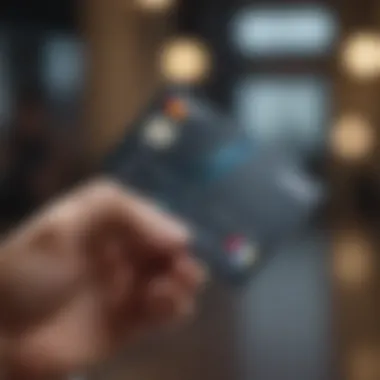Mastering Credit Card Payments with PayPal


Overview of the Topic
In the landscape of personal finance, understanding how to efficiently utilize credit cards through PayPal can significantly enhance one’s transaction experience. With increasing numbers of individuals turning to digital platforms for their financial activities, grasping the nuances of this process becomes paramount.
PayPal operates as a facilitator, providing users the ability to link their credit cards for seamless payments. The importance of mastering this system can't be overstated—it not only shapes how transactions are conducted but also influences issues of security and convenience. By leveraging PayPal’s functionality, users can enjoy a centralized payment method, cutting down on the hassle of multiple accounts.
Key Benefits and Implications
Several key benefits emerge from using credit cards with PayPal:
- Enhanced Security: One of the primary concerns for any online transaction is security. PayPal acts as a buffer between the buyer and the seller, minimizing the risk of credit card fraud.
- Convenience: Linking a credit card allows for quick and easy payments without needing to input card details for every transaction.
- Rewards: Users can continue to earn credit card rewards on purchases made through PayPal, offering additional financial incentives.
Yet, one must also consider potential implications, such as fees charged for specific transactions or delayed refunds when disputes arise. Evaluating these aspects is crucial for making informed choices catering to one’s financial goals.
Exploring Strategies and Tips
When implementing the linking of credit cards to PayPal, certain practical strategies can optimize the user experience.
- Use a Secure Network: Always ensure that transactions are conducted over a secure Wi-Fi connection. Avoid public networks as much as possible.
- Regularly Update Passwords: To guard against unauthorized access, change passwords periodically and follow PayPal’s security recommendations.
Managing Fees
Effective management of any fees associated with credit card payments through PayPal can improve overall satisfaction with the service. Users should:
- Analyze Fees: Keep an eye on transaction fees, particularly for international payments or currency conversions. Understanding these costs ahead of time can prevent unwelcome surprises.
- Use Promotional Offers: Look out for promotions or incentives offered by PayPal on certain transactions as they can save users money in the long run.
Case Studies and Examples
Exploring real-life cases illuminates the successful application of linking credit cards to PayPal. For instance, many small business owners who sell products online have reported a smoother checkout experience with PayPal, resulting in increased sales due to frictionless payments.
Conversely, a common pitfall arises when users overlook the fee structure. For example, one freelancer accidentally incurred hefty charges while invoicing clients overseas due to misunderstanding PayPal’s fee system. This highlights the importance of thoroughly researching before commencing transactions.
Comparison of Financial Products
A variety of financial products are available that can complement the use of credit cards with PayPal. Factors should be weighed when choosing:
- Credit Card Offers: Look for cards that provide favorable cashback or rewards when used with PayPal.
- Debits or Prepaid Options: While PayPal allows linking to debit cards, users might miss out on credit card benefits such as grace periods or higher purchase protection.
Analyzing the pros and cons of these products can aid users in tailoring their financial tools to align with personal spending habits and goals.
Expert Insights and Recommendations
Financial experts recommend maintaining a balanced approach when engaging with PayPal and credit cards. As one finance guru advised, "Keep your payments as simple as they can be, but never sacrifice security for convenience."
Combining the benefits of both PayPal and credit cards can lead to enhanced financial efficacy—if done thoughtfully. By staying aware of potential fees and managing transactions proactively, users can navigate this landscape for optimal benefits while ensuring their financial safety.
Prelude to Credit Card Payments and PayPal
In today's fast-paced digital world, understanding how credit card payments function through platforms like PayPal is essential. Consumers and businesses alike benefit from the agility and efficiency that these payment methods provide. With credit cards becoming a cornerstone of financial transactions, integrating them into PayPal enhances payment convenience, security, and overall financial management.
The Significance of Credit Card Payments
Credit card payments hold significant value in modern commerce. They not only simplify transactions but also provide consumers with flexibility in their spending. One of the primary advantages is that credit cards allow users to make purchases even when cash flow is tight, so long as they can pay the bill later. For instance, if someone needs to purchase a new appliance but doesn't have enough cash at hand, using a credit card lets them make that purchase right away, with the option to pay over time. This can be especially helpful during emergencies or unexpected expenses.


Furthermore, credit cards often come with perks such as rewards programs, which can lead to cashback or points redeemable for future purchases. This feature tantalizes consumers to think of their spending not just in terms of obligations, but as opportunities to accumulate rewards and potentially save money in the long term. However, a keen understanding of interest rates and the discipline to pay off balances on time is crucial to avoid falling into a debt trap.
Overview of PayPal as a Payment Gateway
PayPal has revolutionized the way people transact online since its inception. As a payment gateway, it serves as a bridge between buyers and sellers, enabling secure transactions without sharing sensitive bank details. This aspect is particularly appealing in an environment where online fraud is prevalent.
By linking credit cards to their PayPal accounts, users can take advantage of numerous benefits, such as:
- Increased Security: With PayPal acting as an intermediary, users do not expose their credit card information directly to merchants, reducing the risk of data breaches.
- Convenience: Transactions conducted through PayPal are generally quick and straightforward, allowing users to make payments faster than traditional methods.
- Global Reach: PayPal supports a broad range of currencies, making it easier for consumers to shop internationally without the hassle of dealing with currency conversions directly.
In essence, using PayPal in conjunction with credit card payments creates a seamless online purchasing experience that prioritizes both convenience and security, attributes highly valued in today’s digital economy.
"Integrating credit card payments via PayPal can streamline your financial dealings, making everyday transactions smoother and less cumbersome."
Understanding these components lays the groundwork for maximizing personal and business finance strategies. Moving forward, we’ll delve deeper into the process of setting up PayPal for credit card payments.
Setting Up PayPal for Credit Card Payments
Setting up PayPal for credit card payments is a crucial step for those interested in modern financial transactions. It allows individuals and businesses to handle payments seamlessly without digging through countless other options. With PayPal's widespread acceptance and user-friendly interface, many prefer it as their go-to payment method. However, there are some specific steps and thoughtful considerations to take into account when you’re diving into credit card transactions via this platform.
Creating a PayPal Account
To jumpstart your journey, the first thing you'll need is a PayPal account. The registration process is fairly straightforward. You’ll have to provide some personal information like your email address and a strong password. After that, you'll fill out additional details like your name, address, and phone number. Take the time to use an email that you check regularly. Having access to your email is essential for managing any issues that could arise later.
After registering, make sure to check your email and confirm your account. This confirmation is important; otherwise, your account won’t be fully functional. Once that’s done, you’re halfway there!
Linking Your Credit Card
The next essential step is linking your credit card to the PayPal account. By connecting your credit card, you enable PayPal to pull payments directly when needed. This process typically involves logging into your PayPal account and navigating to the wallet section.
You will have to enter your credit card number, expiration date, and CVV code. Keep this information handy, as you may need it for verification. Once you submit this data, PayPal may perform a small temporary charge to verify that the card is active and owned by you.
This linking process not only streamlines payments but also enhances your buying experience, making transactions quick and hassle-free. Furthermore, with your credit card linked, you can manage purchases more effectively when shopping online.
Verifying Your Credit Card
Verification of your credit card adds an extra layer of security to your online transactions. PayPal employs this step to protect users from fraud and unauthorized access. After linking your card, PayPal typically places a small charge (a dollar or less) on your credit card. This is only temporary, and you will usually see a refund shortly thereafter.
To complete the verification, you’ll need to check your credit card statement, note the amount of that charge, and enter it back into your PayPal account in the verification section. This ensures that you are the legitimate owner of the card. If you skip this step, your ability to use your credit card for payments on PayPal may be limited.
By taking the time to set up and verify your PayPal account, you are investing in a more secure and efficient way to handle your financial transactions.
In summary, setting up PayPal for credit card payments is an essential step that makes online shopping considerably easier. First, you create a PayPal account, then link your credit card, and finally verify the card to ensure it’s secure. Each of these steps plays a vital role in enhancing user experience, allowing for smooth and easy transactions down the line.
Making Payments with a Credit Card through PayPal
When it comes to digital transactions, knowing how to make payments using a credit card through PayPal is critically important. In today's fast-paced world, where accessibility and security are paramount, PayPal stands out as a reliable choice. It allows users to quickly settle transactions, be it for online shopping, services, or even donations, all while using a credit card without revealing sensitive information.
PayPal acts as an intermediary, providing an extra layer between the buyer's credit card and the seller. This not only helps in safeguarding personal financial information but also facilitates easy refunds in case of disputes.
Initiating a Payment
To initiate a payment using a credit card through PayPal, one first needs to navigate to a website that accepts PayPal as a payment method. This could be a myriad of online retailers or service providers. Once you’ve clicked on the PayPal option at checkout, you’ll be directly taken to the PayPal interface. Here, if you're a returning user, you simply log into your account.


However, if you’re a first-timer and wish to use your credit card without creating an account, you can select the option that allows you to pay as a guest. Simply fill out the required fields, including your credit card details and billing address. Be sure to double-check for accuracy before submitting, as one small mistake can cause a hiccup in the transaction.
Understanding Transaction Fees
Next comes the crucial aspect of transaction fees. While using PayPal, it’s essential to differentiate between personal and commercial transactions as the fee structure can vary significantly. For personal payments, if you’re sending money to friends or family, using a credit card often incurs a fee. PayPal usually charges around 2.9% + a fixed fee based on the currency for commercial transactions.
- Key Points to Consider:
- Always confirm who’s footing the transaction fee—you or the seller.
- Some merchants may absorb this fee, while others may pass it on to you.
- International transactions may involve additional currency conversion fees.
Given the potential for unexpected charges, it’s wise to be informed and perhaps even reach out to the merchant in advance for clarification.
Payment Confirmation and Security Measures
Once you initiate the payment, you’ll receive a confirmation page displaying the details of the transaction. This includes the amount charged, the recipient, and a unique transaction ID which can be crucial for tracking.
PayPal employs robust security measures to protect your data. Each transaction is encrypted, safeguarding your credit card information from prying eyes. Additionally, you have the option to set up two-factor authentication for an added layer of security.
Important Note: Always ensure that the website you are purchasing from is reputable and secure to avoid phishing scams. Look for the "https://" at the beginning of the URL.
Advantages of Using Credit Card Payments via PayPal
Utilizing credit cards for payments through PayPal presents a multitude of advantages that cater to a wide array of user preferences and needs. In today's fast-paced digital economy, understanding these benefits is crucial, particularly for someone looking to safeguard their financial transactions while enjoying the dynamism of electronic commerce. From enhanced security features to the allure of rewards programs, let's embark on an exploration of the core advantages that make credit card payments via PayPal a go-to choice for many.
Enhanced Security Features
One of the biggest concerns when making financial transactions is security. When you use credit cards through PayPal, you effectively put an extra layer between yourself and potential online threats. PayPal's security protocols, such as encryption services and fraud detection systems, are designed to protect sensitive information. Here’s how they do it:
- Encryption: PayPal uses advanced encryption to protect personal and financial data. This means that sensitive information is scrambled into a format that cannot be easily intercepted.
- Two-factor authentication: Users can activate another layer of security by requiring a code sent to their mobile device before authorizing a transaction, a practice that minimizes the risk of unauthorized access.
- Fraud protection: PayPal’s fraud prevention unit monitors transactions for suspicious activities, alerting users if anything seems amiss. The level of monitoring provided can give one peace of mind.
"Using PayPal is like having a security guard for your online shopping, keeping a keen eye for any shady activity."
This focus on security ensures that users can shop online with more confidence, making it easier to focus on the buying experience rather than worrying about the potential for fraud.
Convenience of Accessing Funds
Another noteworthy advantage of linking credit cards to PayPal is the convenience of fund access. In many situations, you can avoid the time-consuming act of entering long card numbers and shipping addresses each time you make a purchase. Instead, everything is stored securely in one place. Here are some key points highlighting this convenience:
- Speedy Checkouts: Once you’ve linked your credit card to your PayPal account, purchasing becomes a matter of mere clicks. This efficiency is especially beneficial for frequent shoppers.
- Mobile Payments: More than ever, people shop via smartphones. PayPal’s mobile app streamlines transactions, allowing users to pay on-the-go without a hitch.
- Cross-platform purchases: With PayPal, you can make purchases from various platforms without the hassle of re-entering information. Whether it’s an online marketplace or a subscription service, convenience is the name of the game.
This sort of convenience can be a real time-saver, allowing you to spend less time fussing over payments and more time enjoying your purchases.
Rewards and Cashback Opportunities
PayPal also opens up avenues for rewards and cashback that might not be accessible through other methods. Some credit cards are specifically designed to offer benefits when used through third-party services like PayPal. Look at some perks:
- Cashback on Purchases: Many credit cards provide a percentage of cashback for every transaction made through PayPal—an incentive that can rack up benefits over time.
- Promotions and discounts: Occasionally, PayPal runs exclusive promotions that can surface when you pay with your linked credit card. Taking advantage of these limited-time offers can save you some coin.
- Bonus points: Some credit card companies offer loyalty points for transactions made via PayPal, enriching your overall spending experience and providing rewards that can be redeemed later.
By utilizing credit cards with PayPal, users can maximize the value of their spending, turning ordinary shopping into an opportunity to earn rewards.
In summary, using credit cards through PayPal offers enhanced security, convenient access to funds, and attractive rewards. These factors can significantly elevate the overall user experience, making it a worthwhile consideration for anyone venturing into the realm of online payments.
Considerations When Using Credit Cards with PayPal


When it comes to managing personal financing in the digital age, understanding the nuances of using credit cards with PayPal is paramount. PayPal has carved a niche as a go-to platform for online transactions, enabling users to leverage their credit cards while maintaining a level of security and convenience that's hard to beat. However, before diving into transactions, there are certain considerations that warrant attention to ensure a smoother experience and to make informed financial decisions.
Evaluation of Fees and Interest Rates
One of the first things that catch the eye when using credit cards through PayPal is the variety of fees and interest rates that can pop up. Users might find themselves scratching their heads over processing fees, which typically vary depending on whether they're making a purchase or sending money to friends or family.
- Transaction Fees: PayPal usually charges sellers a percentage of the transaction value plus a fixed fee. For buyers, these fees are often invisible, but they can indirectly affect product pricing.
- Interest Rates: If opting to finance a purchase via PayPal Credit, be sure to review the interest rates carefully. Some promotional rates may appear enticing but can flip into high APRs if not paid within a specified time frame.
In essence, always crunch the numbers beforehand. Evaluating these costs before completing a transaction can save a bundle.
Understanding Chargebacks and Disputes
Another layer of complexity comes with the idea of chargebacks and disputes. It is essential to grasp how these processes work, as misunderstanding them could lead to unwanted headaches.
- What is a Chargeback?: A chargeback occurs when a consumer disputes a transaction, prompting the bank to reverse the charge. This can create quite the stir, especially for sellers operating on tight margins.
- Filing a Dispute: Users can initiate disputes through PayPal’s resolution center. However, they should always furnish solid evidence supporting their claim – the more information, the better the chances of a favorable outcome.
Understanding these intricacies, such as the timeframes and conditions for initiating chargebacks, can empower users when they hit roadblocks in transactions.
Impact on Credit Score
Lastly, let's not overlook the implications for credit scores when using credit cards through PayPal. Making timely payments is critical, but the relationship can extend beyond just keeping up with monthly dues.
- Credit Utilization: This is the ratio of credit card balances to credit limits. A higher utilization rate can negatively influence your credit score; thus, using PayPal to make large purchases might inadvertently affect this balance if the credit card amount remains high.
- Payment History: On-time payments are crucial. Keep in mind that missed payments can lead to late fees, but more seriously, they can have a long-lasting impact on one’s credit score.
Exploring Alternatives to Credit Card Payments on PayPal
When it comes to managing your payments through PayPal, exploring alternatives to credit card transactions is an important consideration. While credit cards are widely used for their convenience, various other payment options may fit your financial needs and preferences better. Understanding these alternatives can help in making more informed decisions, potentially avoiding higher fees or interest rates that come with credit card usage. Moreover, utilizing varied payment methods can offer better control over your personal finance while ensuring smoother transactions.
Bank Transfers and Direct Debit
Bank transfers and direct debits are solid alternatives to consider when using PayPal. This method often provides a straightforward way to send money directly from your bank account without the added complexities of credit card processing. One primary benefit is that bank transfers typically involve lower fees compared to credit card transactions, making this option a cost-effective choice over the long run.
With a bank transfer, you’re less likely to face unexpected charges, making it easier to track your expenses. It’s also worth noting that transfers through PayPal from your bank may process instantly or within a few hours, which is almost as quick as credit card payments. Direct debit, on the other hand, allows an automatic withdrawal from your bank account for recurring payments, which can be beneficial for things like subscription services. This means you don’t have to worry about missing a payment or running the risk of incurring late fees.
However, it's crucial to keep in mind that both options can take longer to settle compared to credit card payments, especially if you're dealing with international transactions. This could cause a slight delay when securing your purchases, so timing is something to consider.
PayPal Credit and Financing Options
Another interesting alternative is PayPal Credit. This line of credit allows you to make purchases through PayPal and pay over time, which can be a great solution for larger expenses. Users can opt for flexible repayment terms which grant some leeway when managing finances. The "No Payments and No Interest if paid in full in 6 months" offer can particularly appeal to those who need a bit of breathing room financially.
However, there are important factors to consider. While it may seem like a tempting option, the interest rates for PayPal Credit can be steep if not managed properly. If full payment isn’t made before the promotional period ends, users might find themselves facing high interest charges, which could turn a seemingly good deal into a financial burden. Additionally, this option can affect your credit score, similar to traditional credit cards. It's essential to monitor your spending and repayment activities closely to maintain financial health while using PayPal Credit.
In essence, looking beyond credit cards for your PayPal transactions could provide various advantages, tailored to individual needs and goals. As you navigate these options, it’s vital to evaluate the pros and cons fully, ensuring a smooth path in your financial journey.
The End
In wrapping up the discussion surrounding credit card payments through PayPal, it is essential to grasp the multi-faceted role that this payment platform plays in today’s digital economy. With an increasing shift towards online transactions, understanding the nuances of using credit cards via PayPal becomes vital for both consumers and businesses alike. Users benefit from enhanced security measures, convenience, and potential rewards associated with credit card transactions. Furthermore, knowing how to navigate fees and interest can make all the difference, allowing individuals to maximize their purchasing power while minimizing unnecessary costs.
Summarizing Key Insights
To summarize, this article has explored various aspects of using credit cards with PayPal, from the fundamental setup processes to evaluating the advantages and drawbacks pertinent to this payment method. Key points include:
- Setup Process: Creating a PayPal account and linking credit cards can be done swiftly, ensuring a seamless experience for users.
- Security Features: PayPal offers robust protection against fraud, making it a secure choice for online purchases.
- Transaction Fees: Understanding the costs associated with transactions helps in making educated decisions before processing payments.
- Alternative Payment Methods: Aside from credit cards, PayPal allows for diverse payment options that can cater to different needs and preferences.
"Navigating the digital payment landscape is more than just convenience; it's about making informed choices that align with one’s financial goals."
Final Thoughts on Using Credit Cards with PayPal
When it comes to using credit cards with PayPal, knowledge is more than just power; it’s a means to achieving efficient financial transactions. By comprehensively understanding the features and limitations of this payment method, users can effectively tailor their online shopping experiences to fit their needs. With a little foresight regarding transaction fees, potential impacts on credit scores, and keeping security at the forefront of considerations, individuals can enjoy the convenience that PayPal brings without facing pitfalls. Efforts to maintain awareness of these elements enable smoother transactions, enhancing overall satisfaction in an increasingly digital shopping world.



